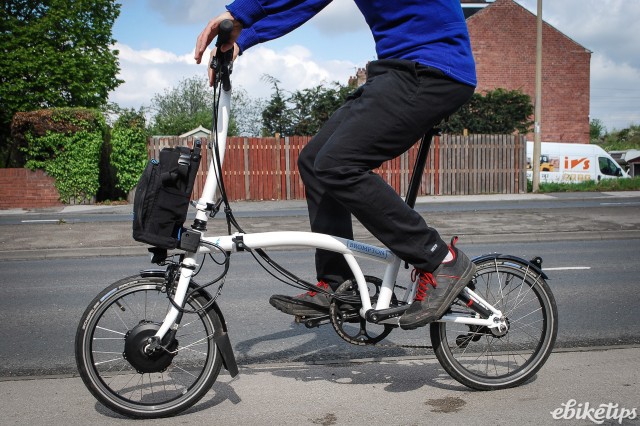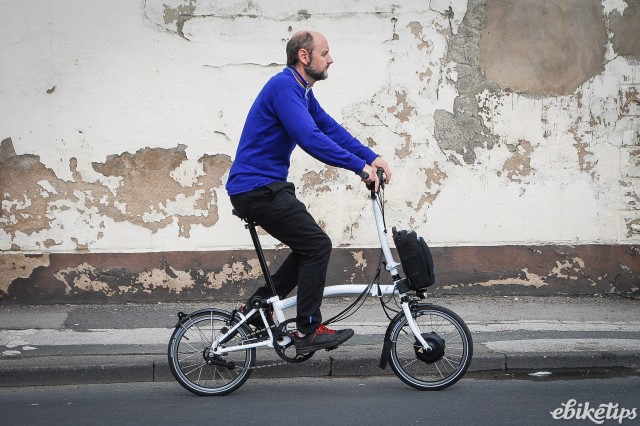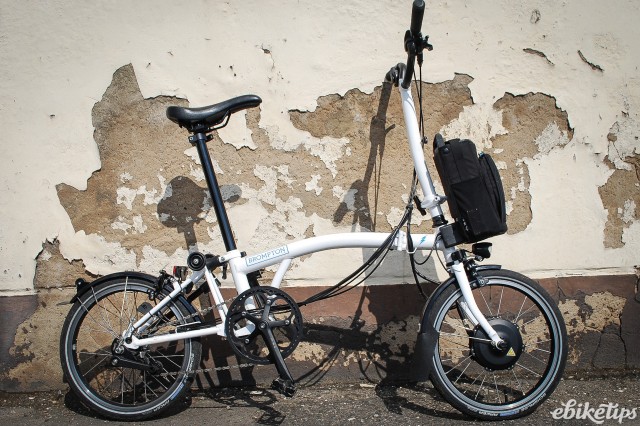Brompton ML6 Electric

Overview
- Neat design that retains the classic Brompton fold and geometry
- Powerful for a relatively small hub motor
- Efficient
- Motor can't be retrofitted to existing non-electric Bromptons
- No power control on the handlebar
The Brompton Electric was a long time in the making, and gradually rolled out from mid 2017 onwards. Only now though, does it seem that the bike is much more widely available and backed by a proper marketing campaign by Brompton. Strong take-up for the electric version would see yet more production activity at their factory in Greenford, West London, partly with a view to expanding production for their electric models. The iconic ‘Made in London’ still appears on the electric version like their classic models.
The Brompton has few rivals in terms of the compactness of fold, portability and suitability for bike and train commuting. This has helped the brand to achieve great success in many cities around the world, in part helped through Brompton’s chain of international own-brand stores.
This hugely successful folding bike design – a design that rides surprisingly well too, despite those 16” wheels – hasn’t been radically altered to accommodate the front hub motor, electronic control box and 312Wh battery. It’s the same size folded up and has the same geometry that gives it a pretty fast and stable ride.
Brompton opted to design their own system in cooperation with Williams Engineering (of Formula 1 fame) presumably so that they could fit the motor snug within the narrow dropouts; plus having control over the planetary gears inside that determine, like all hub gear systems, at what speed you get most assistance.
It’s a neat-looking unit and the front wheel is easily removable, as the power feed cable can be split via a screw fitting, should you have a puncture or need to remove the wheel for maintenance. The cabling to the control box housed behind the clever battery mount is also very neat, and the battery pack slips easily onto the mount, retracting a protective cover as it slides on which allows the battery to connect. Removal is similarly easy, you just push a button and pull the battery off. The battery itself is housed in a small bag with enough capacity for a charger in the front pocket, and smaller accessories in two side pockets (the larger City Bag with more storage). It features a USB port for charging devices on the go, and the bike battery itself can be charged while still in its bag.
For me, the obvious downside to this is that existing Brompton owners can’t retrofit the motor system, so if you want an electric Brompton you need to buy the whole bike.
The location of the battery on the front luggage mounting block means you inevitably lose some carrying capacity here, and the location of the blue LED-lit control buttons on top of the battery, sleek and futuristic though they are, means you have to lean over the bike to use them. Sometimes on flats I found myself approaching a large hill and wanting to add some power, but that meant taking my eyes off the road and one hand off the handlebars to be able to change on the fly. This isn’t ideal, and the system seems to be crying out for a handlebar control, ideally a wireless one. The LED lighting controls are also found on the top of the battery, but as there’s a very handy automatic setting, you won’t really need to use them much. The lights themselves are high quality and powerful Busch and Muller models.
The total weight of my six speed test bike was 17.7kg on digital scales. This doesn’t sound light, but it ranks as reasonably light for an electric bike and a bit better than OK for an electric folder. It’s a pity none of the titanium Brompton options are available in electric versions to lighten it further. An advantage of the removable battery bag is that you end up with a separate 3.7kg of luggage on your back/in your other hand and then the rest of the bike is down to 14kg when you’re transporting it – much more manageable. If you are carrying it unfolded with the battery on, for instance up steps, the bike is more balanced than it looks if you place one hand under the front end of the main part of the frame, and hook the front of the saddle over your shoulder for stability.
My M6L Brompton Electric test bike certainly leapt into action around the Pennine foothills, and conquered all the testing gradients thrown at it. The torque sensor system as set up by Brompton required perhaps a little more human pedal power than some other systems in my opinion (especially crank drives) to get the motor to respond powerfully; it was quite difficult to gauge exactly when the power would kick in. Still, once it started to hum steadily it also got into its stride up the hills. The good thing about the need for more of your own effort is that it appeared to moderate the power output which gave me more range. I used the bike on a variety of routes in widely varying weather conditions, and I’d estimate that it lasted me around 30 miles over hilly terrain – pretty efficient if you ask me.
The dual pivot caliper brakes did a decent job of stopping me, and the six evenly spaced gears were more than adequate when combined with the power from the motor for my Pennine foothill testing ground. The motor seems to have a nice smooth freewheel too, meaning the bike didn’t noticeably drag over the 15mph cut-off limit, especially on the flat or up moderate hills. This also meant pedalling without power was fine in the right conditions too.
While the usual large range of colour and spec options aren’t available for electric Bromptons, you do get the choice between the six gear version I had on test, or a two speed option at £2,592. The two gear option gives a gear range of 133%, whilst the six gear option gives a 302% option but increases the weight by around a kilo.
As mentioned before, the ‘Essential’ battery bag can be changed for the City Bag (£130 extra) that adds a bit of extra storage space around the battery. You can choose between a black or white frame and you also have the option of higher profile handlebars for taller riders.
Overall I liked the practicality of the Brompton Electric and its efficient motor, although I’d like to see a handlebar-mounted control system to make it easier to adjust the power.
4 comments
Addendum: Another company (Swytch) also do a conversion : https://www.swytchbike.com/p/universal-swytch-ebike-kit/?gclid=CjwKCAjw__fnBRANEiwAuFxET3h_6o9nksT5BtPYxoZ4iYpXjvndSwatW8R9o9HiovDkeiNUWWBu-BoCudIQAvD_BwE
R.
I have an old 5-speed Brompton and converted it using a 'Nano' kit. (https://www.nanoelectricbikes.co.uk/#&gid=1&pid=1)
One needs to widen the front forks slightly to fit the new front wheel...but it works well - especially if you already have a suitable Brompton bag.
No connection with the company.
Brompton could not produce a retrofit kit because the bike had to be strengthened to meet e bike regulations. Regular Bromptons are not produced to meet e-bike certifications.
For years Brompton have claimed "backwards compatibility" as a justification for keeping all manner of parp components on the latest models and now along comes a game-changer and it cannot be retro-fitted to existing B's. They are really missing a trick in not producing a "kit" that retrofits.
That said the lack of bar mounted controls smacks of a designer who has looked at the e- and not the -bike in e-bike. Maybe they'll get it right on the next iteration.












